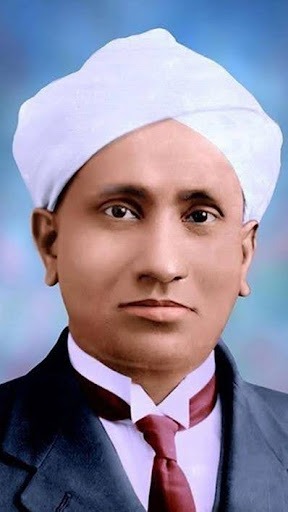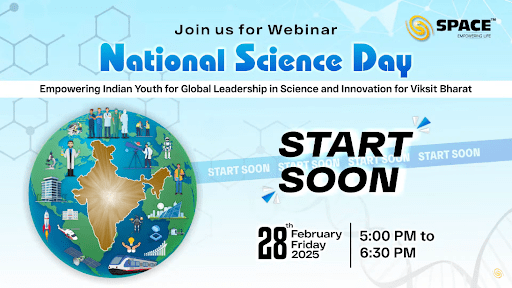“Science is not just a subject; it’s a way of thinking, questioning, and exploring the unknown.” Imagine a young student looking up at the night sky, dreaming of unravelling its mysteries. Or an aspiring scientist working late into the night, experimenting, failing, and trying again—just like Sir C.V. Raman did when he discovered the Raman Effect in 1928. National Science Day is more than just a celebration; it’s a tribute to the spirit of curiosity and innovation that drives human progress.

In 2025, the theme “Empowering Indian Youth for Global Leadership in Science and Innovation for Viksit Bharat” highlights the important role of young minds in creating India’s future as a scientific powerhouse. Space India hosted a prestigious National Science Webinar with distinguished scientists and thought leaders who discussed their views and experiences on the progress of scientific knowledge and inspiring the younger generation.
Legacy of Sir C.V. Raman and Significance of Science Day:
Sir Chandrasekhara Venkata Raman was a pioneer in light scattering, famously demonstrating that light changes wavelength when passing through transparent materials—a phenomenon now known as the Raman Effect. His discovery revolutionized the field of optics and photonics, influencing generations of scientists. His impact extended beyond physics; he nurtured Indian scientific institutions like the Indian Academy of Sciences and the Raman Research Institute, shaping India’s research landscape.
National Science Day was observed at Space India with the objective of science and technology popularization and debating developments in STEM (Science, Technology, Engineering, and Mathematics) disciplines. Live webinar on 28th February offered a platform to discuss the burning issues, new-age technologies, and revolutionary innovations that can propel national advancement.
Renowned Panellists and Their Vision for Science in India:
The webinar included renowned scientists and researchers presenting insightful views across different domains, ranging from space science to material sciences and gender equality in STEM.

Ms. Shaguna Gahilote – UN Women India: Championing Gender Equality in STEM. Ms. Gahilote pointed out that the representation of women in STEM is crucial. She explained that numerous women study in the field of STEM, but fewer of them appear in leadership positions. In order to close the gap, UN Women India is actively advocating for programs like:
- More women are joining the field of STEM careers.
- Designing inclusive and safe working environments for women scientists.
- Implementing mentorship initiatives to empower women in science.
She highlighted the significance of interdisciplinary approaches, where arts and storytelling can also be used to make science more accessible and engaging.
Dr. Parveen Saini – CSIR-National Physical Laboratory: Advancing Materials Science and Renewable Energy. Dr. Saini focused on the crucial role of advanced materials in scientific progress, particularly in areas like graphene technology, conducting polymers, and waste-to-wealth innovations. He stressed that young researchers should focus on:
- Developing technologies related to renewable energy, e.g., enhancing solar panel efficiency.
- Investing in inexpensive and sustainable materials for industrial processes.
- Promoting indigenous technology to curtail import reliance.
His best advice to students was to remain inquisitive, accept failures, and continue scientific inquiry.
Dr. Santosh Vadawale – Physical Research Laboratory: India’s Space Research and the Future Dr. Vadawale gave incisive observations about India’s increasing leadership in space research, elaborating its contributions to space missions such as Chandrayaan, Aditya-L1, and the future Venus Orbiter Mission.
He emphasized:
- The contribution of astronomy and planetary science to unfolding cosmic secrets.
- The way space exploration fuels the curiosity of the scientific mind of the young.
- India’s forthcoming deep-space missions and interplanetary exploration agenda.
His motivational message to would-be scientists was, “Make science your passion. Understanding the universe is a lifelong journey.”
Science in Everyday Life: From Water Purification to Waste Disposal
Aside from space and materials science, the webinar also touched on how science influences everyday life, including:
- Technologies for water purification that ensure clean drinking water.
- Innovations in recycling to minimize landfill waste and ensure sustainability.
- Renewable energy technologies to combat climate change and energize the future.

These instances illustrated how scientific research is converted into real-world societal gains, making innovation the vital force for progress.
Inspiring the Next Generation of Scientists:
One of the most important topics was how to inspire young students to study STEM. The panellists urged:
- Inquiry-based learning to foster curiosity and problem-solving.
- Hands-on experiments and practical applications make science interesting.
- Mentorship programs that pair students with veteran researchers.
Dr. Saini also emphasized the significance of failure in making scientific breakthroughs, telling the students not to be afraid to fail but utilize failure as a stepping stone.
Conclusion: A Future Led by Scientific Superiority National Science Day 2025 acted as a trigger for galvanizing the minds of youth, reaffirming India’s commitment to advancing science and world leadership.
With its adoption of innovation, cross-disciplinary interaction, and access to STEM in inclusivity, India is gearing towards empowering the youth and becoming an even greater science leader on the world map. As we keep venturing into new horizons, let us not forget that science is not merely about finding the unknown but also about unleashing our own boundless potential.
Let’s keep reaching for the stars!
—
If you like the blog, enroll your school or yourself (k-12 student) in our School Programs or Online Programs, call us at +91-74020 74020 or write to us for any query: getintouch@space-india.com

